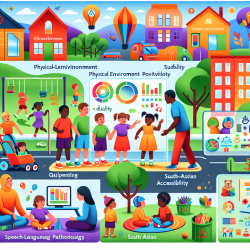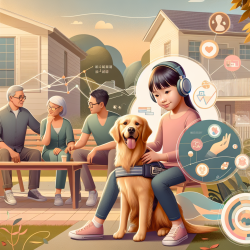Introduction
As a passionate advocate for child development and well-being, understanding the impact of neighborhood quality on health outcomes is crucial. The research article "Measuring Physical Neighborhood Quality Related to Health" provides valuable insights into how physical neighborhood attributes influence health. This blog will explore these findings and suggest how practitioners, especially those in speech-language pathology, can apply this knowledge to enhance their practice and encourage further research.
The Importance of Physical Neighborhood Quality
Neighborhood quality has often been equated with socioeconomic status, but this perspective overlooks the significant role of physical attributes. The research highlights several key physical neighborhood attributes that can impact health:
- Land use and density
- Street connectivity and transportation infrastructure
- Access to nature, green spaces, and public resources
- Building and street condition, cleanliness, and maintenance
- Traffic volume, air quality, and noise levels
These factors have been linked to various health outcomes, including obesity, chronic diseases, mental health issues, and social well-being. Understanding these connections is essential for practitioners aiming to improve health outcomes in children.
Methodological Challenges and Future Directions
The research article discusses the methodological challenges in measuring physical neighborhood quality and its effects on health. These challenges include:
- Research Design and Causal Inference: Most studies are cross-sectional, making it difficult to establish causality. More rigorous methodologies, such as longitudinal studies, are needed.
- Selection Bias: Individuals often choose neighborhoods based on personal traits, complicating the attribution of health outcomes to neighborhood quality.
- Time and Spatial Scale: Neighborhood conditions are dynamic, and the timing and spatial scale of observations can affect results.
To address these challenges, the research suggests a combination of strategies, including the development of theories linking physical neighborhood quality to specific health outcomes, and the use of advanced methodologies like natural experiments and multilevel modeling.
Implications for Practitioners
For practitioners, particularly those in speech-language pathology, understanding the impact of neighborhood quality on child health is vital. Here are some ways practitioners can apply this knowledge:
- Advocacy: Advocate for improved neighborhood conditions that support healthy child development, such as safe play areas and accessible green spaces.
- Collaboration: Work with community planners and policymakers to address neighborhood issues that may affect children's health and development.
- Research and Education: Engage in research to further explore the connections between neighborhood quality and health outcomes. Educate families about the importance of neighborhood environments.
Encouraging Further Research
While the current research provides valuable insights, there is still much to learn about the relationship between neighborhood quality and health. Practitioners are encouraged to contribute to this field by conducting studies that explore these connections further, particularly in diverse settings and populations.
To read the original research paper, please follow this link: Measuring Physical Neighborhood Quality Related to Health.










